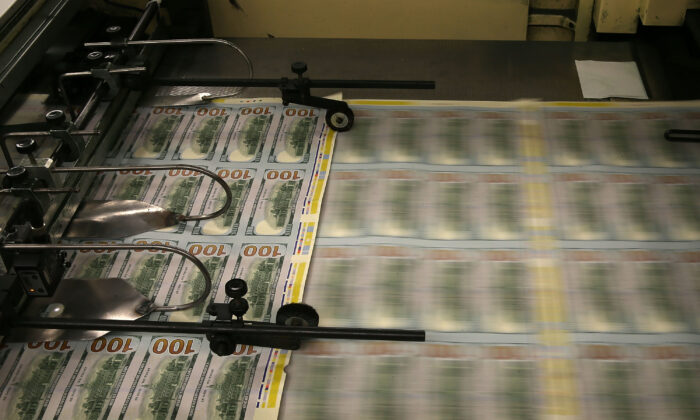News Analysis
Money-supply growth rose year over year in November for the fourth month in a row, the first time this has happened since the four months ending in October of 2022. The current trend in money-supply growth suggests a significant and continued turnaround from more than a year of historically large contractions in the money supply that occurred throughout much of 2023 and 2024. As of November, the money supply appears to be entering a new and accelerating growth period.
In November, year-over-year growth in the money supply was at 2.35 percent. That’s a 27-month high and the largest year-over-year increase since September 2022. November’s growth rate was up from October’s growth rate of 1.45 percent. It’s a large reversal from November 2023’s year-over-year decline of 8.5 percent. Until the current trend of accelerating money-supply growth began, the US money supply had been in the midst of the largest drop in money supply we’ve seen since the Great Depression. Prior to 2023, at no other point for at least sixty years had the money supply fallen by so much.
That downward trend now appears to be well over. Indeed, when we look at month-to-month changes in the money supply, we also find an upward trend. The money supply has increased each month from July through November of 2024. The money supply increased by 0.95 percent from October to November. That’s a nine-month high and is the third-largest increase since March of 2022.
In recent months, M2 growth rates have followed a similar course to TMS growth rates, although M2 is growing faster than TMS. In November, the M2 growth rate was 3.73 percent. That’s up from October’s growth rate of 3.13 percent. November’s growth rate was also up from November 2023’s rate of negative 3.27 percent. Month over month, M2 increased by 0.94 percent from October to November. That’s the largest month-to-month growth rate in nine months.
Money supply growth can often be a helpful measure of economic activity and an indicator of coming recessions. During periods of economic boom, money supply tends to grow quickly as commercial banks make more loans. On the other hand, two or three years before a recession begins, we tend to see periods during which money supply growth slows or turns negative. It should be noted that the money supply does not need to actually contract to signal a recession. As shown by Ludwig von Mises, recessions are often preceded by a mere slowing in money supply growth.
All that said, recessions tend not to become apparent until after the money supply has begun to accelerate again after a period of slowing. This was the case in the early 1990’s recession, the Dot-com Bust of 2001, and the Great Recession. This may be the trend we are seeing now.
Indeed, the acceleration in money-supply growth that we’ve seen in recent months corresponds with new efforts by the Federal Reserve to force down the target policy interest rate, thus spurring more money creation. In September, the Fed’s FOMC cut the target rate by 50 basis points. Such a sizable cut to the target rate is usually followed by a recession since the Fed usually only implements such a large cut when it fears an approaching recession. The Fed cut the target rate again in November, and then again in December.
Moreover, the Fed’s return to dovish policy strongly suggests that the Fed has no plans to unwind the trillions of dollars it added to the economy over the past five years. In spite of last year’s sizable drops in total money supply, the trend in money-supply totals remains well above what existed during the twenty-year period from 1989 to 2009. To return to this trend, the money supply would have to drop another $3 trillion or so—or 15 percent—down to a total below $15 trillion. Moreover, as of November, total money supply was still up more than 35 percent (or about $5 trillion) since January 2020.
Since 2009, the TMS money supply is now up by more than 192 percent. (M2 has grown by 150 percent in that period.) Out of the current money supply of $19.3 trillion, nearly 26 percent of that has been created since January 2020. Since 2009, more than $12 trillion of the current money supply has been created. In other words, nearly two-thirds of the total existing money supply have been created just in the past thirteen years.
Apparently, the Fed now is quite comfortable with this, in spite of the fact that there is no sign of CPI inflation rates returning to the Fed’s arbitrary two-percent price-inflation goal. For example, both CPI and core CPI increased in November’s month-to-month change. The CPI’s year-over-year change increased to 2.7 percent in November. The core CPI remained flat at 3.3 percent over the same period.
In simpler terms, the Fed is not focusing on reducing inflation rates. Changes in money supply and CPI do not have a direct relationship, but with the Fed implementing easy money policies again, we can expect increases in asset and consumer price inflation in the future.
The Fed and the federal government need lower interest rates to manage the huge national debt. Despite the Fed’s efforts to lower interest rates, bond markets have not been cooperative, indicating that deficit spending is likely to continue, leading to inflation.
Bond investors anticipate that the Fed will need to intervene to prevent yields from rising too high, which may result in more inflation. This cycle could eventually lead to higher interest rates again, as we are already seeing with rising longer-term rates.
There is a warning in the market as 5 percent yields on 20-year Treasury bonds are already a reality. Economic growth fueled by government spending is putting pressure on interest rates and future inflation.
The increase in money supply, with the Fed’s support, is contributing to these trends.
Source link










